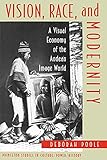Vision, Race, and Modernity : A Visual Economy of the Andean Image World / Deborah Poole.
Material type: TextSeries: Princeton Studies in Culture/Power/History ; 13Publisher: Princeton, NJ : Princeton University Press, [2021]Copyright date: ©1997Description: 1 online resource (272 p.) : 75 halftonesContent type:
TextSeries: Princeton Studies in Culture/Power/History ; 13Publisher: Princeton, NJ : Princeton University Press, [2021]Copyright date: ©1997Description: 1 online resource (272 p.) : 75 halftonesContent type: - 9780691234649
- 305.8/0098 22
- GN347 .P66 1997eb
- online - DeGruyter
| Item type | Current library | Call number | URL | Status | Notes | Barcode | |
|---|---|---|---|---|---|---|---|
 eBook
eBook
|
Biblioteca "Angelicum" Pont. Univ. S.Tommaso d'Aquino Nuvola online | online - DeGruyter (Browse shelf(Opens below)) | Online access | Not for loan (Accesso limitato) | Accesso per gli utenti autorizzati / Access for authorized users | (dgr)9780691234649 |
Frontmatter -- Contents -- List of Illustrations -- Acknowledgments -- VISION, RACE, AND MODERNITY -- Chapter One Introduction -- Chapter Two The Inca Operatic -- Chapter Three An Economy of Vision -- Chapter Four A One-Eyed Gaze -- Chapter Five Equivalent Images -- Chapter Six The Face of a Nation -- Chapter Seven The New Indians -- Chapter Eight Negotiating Modernity -- Notes -- References -- Index
restricted access online access with authorization star
http://purl.org/coar/access_right/c_16ec
Through an intensive examination of photographs and engravings from European, Peruvian, and U.S. archives, Deborah Poole explores the role visual images and technologies have played in shaping modern understandings of race. Vision, Race, and Modernity traces the subtle shifts that occurred in European and South American depictions of Andean Indians from the late eighteenth to the early twentieth centuries, and explains how these shifts led to the modern concept of "racial difference." While Andean peoples were always thought of as different by their European describers, it was not until the early nineteenth century that European artists and scientists became interested in developing a unique visual and typological language for describing their physical features. Poole suggests that this "scientific" or "biological" discourse of race cannot be understood outside a modern visual economy. Although the book specifically documents the depictions of Andean peoples, Poole's findings apply to the entire colonized world of the nineteenth century. Poole presents a wide range of images from operas, scientific expeditions, nationalist projects, and picturesque artists that both effectively elucidate her argument and contribute to an impressive history of photography. Vision, Race, and Modernity is a fascinating attempt to study the changing terrain of racial theory as part of a broader reorganization of vision in European society and culture.
Mode of access: Internet via World Wide Web.
In English.
Description based on online resource; title from PDF title page (publisher's Web site, viewed 30. Aug 2021)


